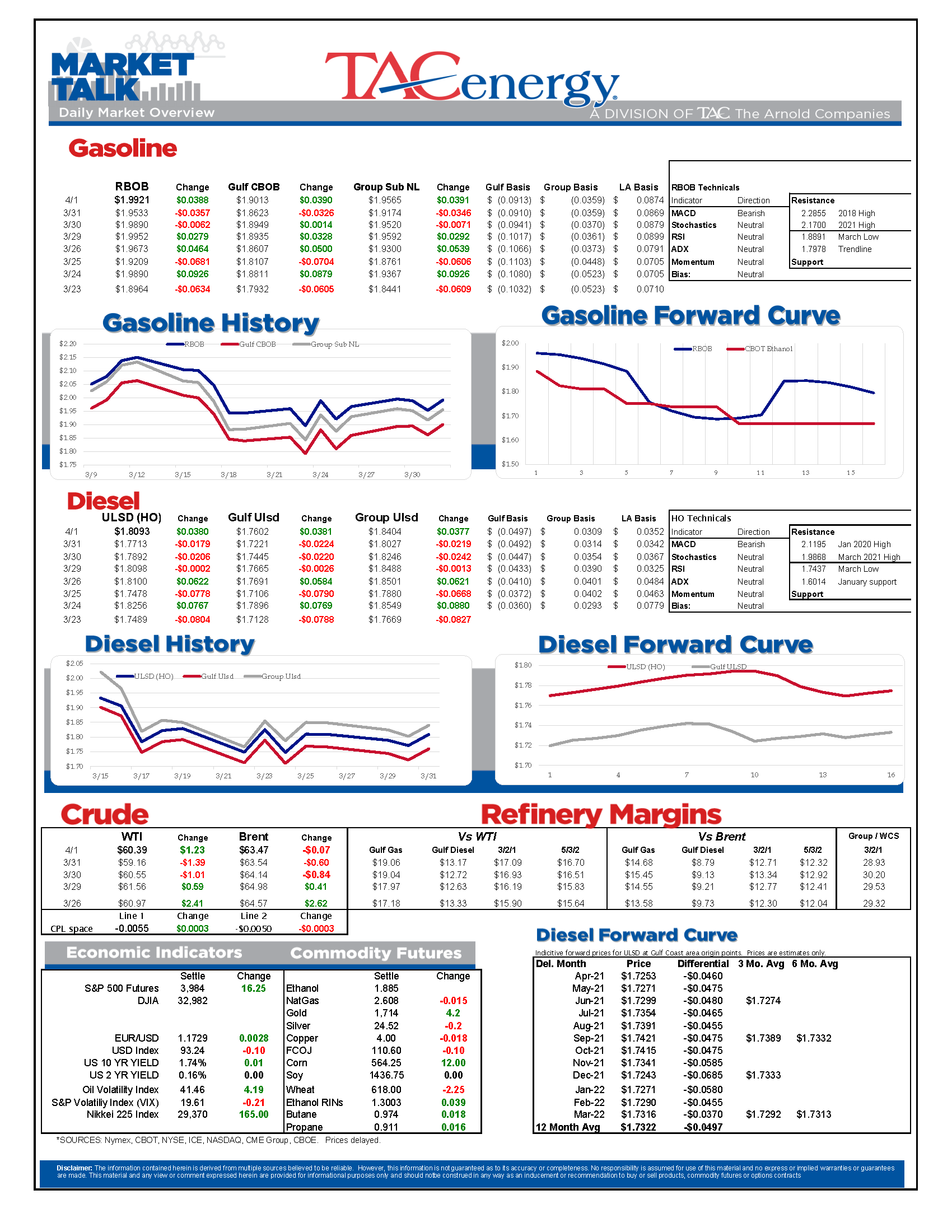Yo-Yo Action Continues In Energy Markets

The yo-yo action continues in energy markets this week after March trading ended with heavy selling, only to see those losses erased in the first few hours of April.
The OPEC policy meeting is today, which will often add to volatility as rumors and speculation run rampant ahead of the official announcement, if they decide to make one. We’re also heading into a rare holiday weekend that will include the March jobs report when markets are closed, which could create some more swings when trading resumes Sunday night.
Yesterday’s DOE report offered good news for both demand and supply in the U.S., as gasoline consumption hit a six month high, and supplies look like they’re almost back to normal levels.
Total U.S. refinery runs have finally returned to the levels we saw six weeks ago before Texas froze over. PADD 3 (Gulf Coast) run rates are still slightly below where they were prior to the storm as several units are still being repaired, but total runs in the region did increase by more than 550mb/day last week.
Those increased run rates can be felt from West Texas to Philadelphia as allocations begin to ease and outages become more rare this week. Colonial pipeline reported earlier in the week that supplies along its system were increasing, alleviating some of the pressure on markets across the South East, but would still need more product input along the Gulf Coast to get back to normal run rates.
Speaking of pressure on Colonial, the PHMSA released a proposed safety order warning Colonial that it must take measures to reduce potential risk along its system after a study of last year’s gasoline leak that ended up being a much bigger deal than originally thought. This report may be much ado about nothing as Colonial has already implemented safety measures, and was using the recent slowdown in operating rates to perform more maintenance, but it will be important to keep an eye on given its outsized influence on supply across a huge part of the country, not to mention the growing list of disruptions over the past five years.
Another sign that things are getting back to normal on the supply side of the economic equation, imports of petroleum products dropped back closer to their seasonal average after hitting their highest levels in a decade following the polar plunge.
RIN prices also continued their rollercoaster ride Wednesday, taking back 6-8 cents of the losses they faced earlier in the week, as lower than forecast planting estimates in the quarterly crop report had grains and soybean oil trading limit up on the day. No word yet if Mr. Beeks had been consulted on the crop report since those products were selling off sharply ahead of the report which certainly has several traders wishing for a do over.
Latest Posts
Week 16 - US DOE Inventory Recap
Energy Markets Trading Quietly In The Red As Ethanol Prices Rally To Five-Month High
The Struggle For Renewable Producers Continues As A Rapid Influx Of Supply And Crashing Credit Prices Make Biodiesel
After Years Of Backwardation, Diesel Prices Have Slipped Into Contango Over The Past Week
Social Media
News & Views
View All
Week 16 - US DOE Inventory Recap

Energy Markets Trading Quietly In The Red As Ethanol Prices Rally To Five-Month High
Energy markets are trading quietly in the red to start Wednesday’s session after a healthy bounce Tuesday afternoon suggested the Israel-Iran-linked liquidation had finally run its course.
There are reports of more Ukrainian strikes on Russian energy assets overnight, but the sources are sketchy so far, and the market doesn’t seem to be reacting as if this is legitimate news.
Ethanol prices have rallied to a 5-month high this week as corn and other grain prices have rallied after the latest crop progress update highlighted risks to farmers this year, lower grain export expectations from Ukraine, and the approval of E15 blends this summer despite the fact it pollutes more. The rally in grain and renewables prices has also helped RIN values find a bid after it looked like they were about to test their 4-year lows last week.
The API reported small changes in refined product inventories last week, with gasoline stocks down about 600,000, while distillates were up 724,000. Crude oil inventories increased by 3.2 million barrels according to the industry-group estimates. The DOE’s weekly report is due out at its normal time this morning.
Total reported another upset at its Port Arthur refinery that’s been a frequent flier on the TCEQ alerts since the January deep freeze knocked it offline and damaged multiple operating units. This latest upset seems minor as the un-named unit impacted was returned to normal operations in under an hour. Gulf Coast basis markets have shrugged off most reports of refinery upsets this year as the region remains well supplied, and it’s unlikely we’ll see any impact from this news.
California conversely reacted in a big way to reports of an upset at Chevron’s El Segundo refinery outside of LA, with CARBOB basis values jumping by more than a dime. Energy News Today continued to show its value by reporting the upset before the flaring notice was even reported to area regulators, proving once again it’s ahead of the curve on refinery-related events. Another industry news outlet meanwhile struggled just to remember where the country’s largest diesel seller is located.
Click here to download a PDF of today's TACenergy Market Talk

The Struggle For Renewable Producers Continues As A Rapid Influx Of Supply And Crashing Credit Prices Make Biodiesel
The sigh of relief selloff continues in energy markets Tuesday morning, with gasoline prices now down more than 20 cents in 7 sessions, while diesel prices have dropped 26 cents in the past 12. Crude oil prices are within a few pennies of reaching a 1 month low as a lack of headlines from the world’s hot spots allows some reflection into the state of the world’s spare capacity for both oil and refined products.
Gasoline prices are trading near a 6-week low this morning, but still need to fall about another nickel in order to break the weekly trendline that pushed prices steadily higher since December. If that trend breaks, it will be safer to say that we saw the end of the spring gasoline rally on April 12th for the 2nd year in a row. Last year RBOB futures peaked on April 12 at $2.8943 and bottomed out on May 4th at $2.2500. The high (at this point) for this year was set on April 12th at $2.8516, and the low overnight was $2.6454.
It’s not just energy commodities that are seeing an unwind of the “flight to safety” trade: Gold prices had their biggest selloff in 2 years Monday and continue to point lower today. Just how much money poured into commodities in the weeks leading up to the direct confrontation between Israel and Iran is unclear, but we have seen in year’s past that these unwind-events can create a snowball effect as traders can be forced to sell to cover their margin calls.
Supply > Demand: The EIA this morning highlighted the record setting demand for natural gas in the US last year, which was not nearly enough to offset the glut of supply that forced prices to a record low in February. A shortage of natural gas in Europe was a key driver of the chaotic markets that smashed just about every record in 2022, and an excess of natural gas supply in Europe and the US this year is acting as a buffer, particularly on diesel prices.
The struggle for renewable producers continues as a rapid influx of supply and crashing credit prices make Biodiesel, RD and SAF unprofitable for many. In addition to the plant closures announced in the past 6 months, Vertex Energy reported Monday it’s operating its Renewable Diesel facility in Mobile AL at just 50% of capacity in Q1. The truly scary part for many is that the $1/gallon Blender's tax credit ends this year and is being replaced by the “Clean” Fuel production credit that forces producers to prove their emissions reductions in order to qualify for an increased subsidy. It’s impossible to say at this point how much the net reduction will be for domestic producers, but importers will get nothing, and at current CI values, many biodiesel producers may see their “blend credit” cut by more than half.
Click here to download a PDF of today's TACenergy Market Talk.
